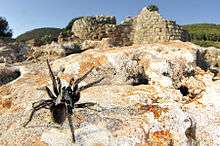Amblyocarenum nuragicus
Amblyocarenum nuragicus, or also Nuragic spider, is a spider in the family Nemesiidae.[1] It is endemic to the Mediterranean island of Sardinia, where it is pretty much common to be found on the surface in the summer, and its scientific name pays homage to the Nuragic civilization. The body length ranges from 17 to 25 mm.
| Amblyocarenum nuragicus | |
|---|---|
 | |
| Scientific classification | |
| Kingdom: | Animalia |
| Phylum: | Arthropoda |
| Subphylum: | Chelicerata |
| Class: | Arachnida |
| Order: | Araneae |
| Infraorder: | Mygalomorphae |
| Family: | Nemesiidae |
| Genus: | Amblyocarenum |
| Species: | A. nuragicus |
| Binomial name | |
| Amblyocarenum nuragicus Decae, Colombo & Manunza, 2014[1] | |
After a study dating back to 2007,[2] the Nuragic spider finally classified as a distinct species from others belonging to the genus Cyrtauchenius only in 2014. Further research upon the peculiarities of this spider has led to differentiate the two genera Cyrtauchenius and Amblyocarenum that, until the aforementioned discovery, were considered to be actually the same.[3] They are now placed in different families.[1]
Albeit similar at first glance, this spider is not to be confused with Cteniza sauvagesi,[4] in that it is quite different from a taxonomical and morphological point of view.
Notes
- "Taxon details Amblyocarenum nuragicus Decae, Colombo & Manunza, 2014", World Spider Catalog, Natural History Museum Bern, retrieved 2020-07-15
- "II ragno del nuraghe - National Geographic Italia". Archived from the original on 2014-11-01. Retrieved 2015-08-13.
- Decae & Bosmans, 2014
- A Porto Conte un ragno tutto sardo ribattezzato “Nuragicus” - La Nuova Sardegna
References
- Decae, Arthur; Colombo, Marco; Manunza, Bruno (2014). "Species diversity in the supposedly monotypic genus Amblyocarenum Simon, 1892, with the description of a new species from Sardinia (Araneae, Mygalomorphae, Cyrtaucheniidae)". Arachnology. 16 (6): 228–240. doi:10.13156/arac.2014.16.6.228.